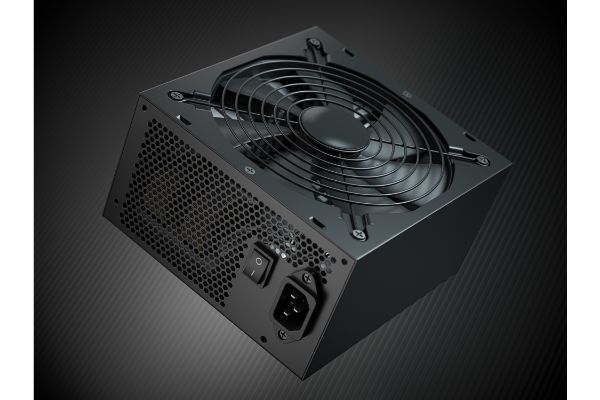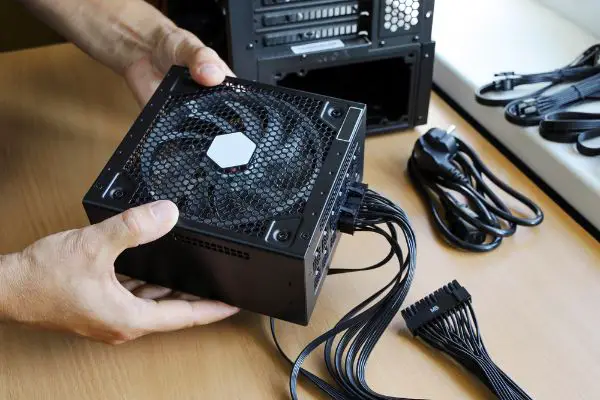Disclaimer: This post may contain affiliate links, meaning we get a small commission if you make a purchase through our links, at no cost to you. For more information, please visit our Disclaimer Page.
When you plug a computer into a power outlet in order to be able to use it, the current goes into the machine’s power supply unit. The desktop needs a power supply of its own so that it can change the AC power in your mains supply to a DC current that has a much lower voltage.
Without this mechanism, there would be too much voltage going through the computer, and it could damage or fry many of the parts, though it may fail to work at all. Once power from your mains gets to the PSU in the computer, that piece of hardware can send it out to the rest of the components inside your rig, thus making sure that each one of them can use the energy they need in order for the whole computer to function.
This explanation covers some basics of the power supply unit, but many people who work with or want to put together computers wonder if the PSU has any drivers of its own.
Other components in the computer do need drivers, so we’ll talk about this topic in relation to PSUs in today’s article. Further, we’ll discuss whether any power supply units might cause some negative issues with how drivers function, and we’ll talk about the likelihood of new PSUs having faults that cause them to work incorrectly.
As we delve deeper into the topic, we’ll also touch on how bad units might cause harm to other parts of the PC, the negative affects dust can have on the PSUs, and users who might opt to go with old power supply units.
Table of Contents
Does a PSU Have Drivers?
Drivers cover a couple of different categories in the PC world. More specifically, device drivers are pieces of software that tell a particular part of a computer how it should interact with other hardware that the system uses.
When we talk about driver software in general, we are referring to a specific kind of interface in programming that helps the system to manage other interfaces that are on a lower level. While that can all be a bit technical, you can think of drivers as a collection of files. These files present instructions that tell a piece of hardware how it should behave.
Although power supply units are certainly part of the hardware of a computer, they should not need drivers in order to function properly. The PSU in your machine needs to convert power and send it out, and much of that job relies on the unit being able to manipulate currents of electricity mechanically.
The task might not be the simplest one that a computer does, but its basic framework is something that a PSU can handle without a driver. Its job is to control the current, and it starts by smoothing out the one that is coming into the computer.
The power supply unit does this via a form of filtering, and it can help in homes that have uneven mains power that supplies energy to lots of devices at once. However, the processes the PSU goes through here don’t take instructions from software files.
Can a PSU Cause Driver Cause Issues?
It may be possible for a power supply unit to cause issues with some of the computer’s drivers. However, this is not the only symptom you should take a look at when you are experiencing problems with your system.
Additionally, it is possible for a PSU to cause other parts of the hardware in your PC or laptop to fail without the unit affecting the drivers themselves. For our purposes, we can talk about what happens in a power supply unit that may cause it to mess with the drivers in other hardware.
Mostly, the problems you might face that you can trace back to your PSU will have to do with the load it is under or the power it is drawing for the computer. These reasons could remain true even if you don’t think the power levels are messing with any drivers in your system, too.
For example, a good power supply needs to be able to provide a steady current to something like the graphics processor, a very hardworking part of your computer.
The GPU helps you see the basic display on the screen when you start the computer. More than that, it takes care of resource-intensive programs that need to render heavy graphics, detailed textures, and special objects on the screen. Gaming is one activity that uses a lot of the GPUs resources. This graphics processor relies on the performance of the power supply unit.
If said unit isn’t drawing enough power, it may not have the energy it needs to power the GPU. Should a situation like this occur, the drivers that act as instruction manuals for the graphics processor could glitch out.
The most common thing that can happen with any major component that is taking energy from a PSU that cannot handle it is that your application or part of your system will freeze up. It may require you to restart the whole computer in order to get things working again.
Even if you do, you should still run checks on device drivers to make sure everything looks like it is in order. If the problem turns out to be more severe, the whole PC or laptop could shut down without any warning whatsoever. While this problem may not go back to any drivers, the interruption of processes could cause later issues with the driver software.
Can a New PSU Be Faulty?
Yes, it is possible for you to get a faulty PSU even though it is brand new and just out of its box. Any product can, unfortunately, display defects right away. Some of these problems may be the result of issues that happened when the developers manufactured the power supply, or they might be things that occurred during the shipping process.
In any case, any kind of item can have a fault from the start, and this is something that can affect mechanical and technical parts more than some others.
If you suspect that your new power supply unit is faulty, try hooking up a different power supply to the computer to see if it will still run. If it will, this points to an issue with your new one. However, it is also a good idea to check the cables, too. There are times when the power supply unit itself might be fine, but you could have a fault in the cable that is not visible to you immediately.
Consider swapping out just the cables to see if the problem resolves itself. Even if you don’t suspect a problem with the cables, check each port and connection to make sure things are secure and that cables are going where they should.
Can a Bad PSU Damage Other Components?
Just like with a new PSU failing to start, a bad one can cause damage to other parts of your PC. It can be hard for anyone to gauge the specific likelihood of an event like this happening, but it is always possible. If the power supply unit fails or dies in certain ways, it can fry any other hardware or devices that connect to it.
Theoretically, a failing PSU might have the potential to take down an entire system, forcing you to rebuild from the ground up or replace some very expensive parts.
All of this is possible, and you may read about some horror stories about this happening in the past. With that said, many modern power supply units from reputable brands have protections that the manufacturers build into them. The goal is to provide filters that can protect other components from the dangers of a PSU that shorts out or dies unexpectedly.
Even basic models from mid-range brands today will usually feature some of these protections, and every PSU developer wants to make sure that their products meet these minimum standards.
We don’t recommend that you go out to buy the cheapest PSU that they can, particularly if you may not know much about how power supplies work. There is always a chance that you end up with a unit that doesn’t have any safety measures like this in place.
Heavy activities that you do regularly on the PC could strain some power supplies, too. Shop around for at least mid-range models from brands that you know and trust, or ask the tech community for good recommendations here.
Can Dust Cause PSU To Fail?
Yes, dust can be problematic for a power supply unit. If the interior of your computer gets too dusty, those particles can accumulate over the PSU. More specifically, your power supply unit has an air intake grill.
If too much dust gets stuck on it, the results might include low airflow that leads to the unit overheating or burning itself out. Further, such a problem could also impact your motherboard. It is best to make sure that the PSU is clean and in good working order.
Is Using an Old PSU Bad?
It is not necessarily bad to use an old power supply unit. In fact, you may even be able to transfer the old one into a new machine. The main things to watch out for are any noticeable dips you have in the power supply and making sure the unit stays clean and free of debris.
If you have not noticed any issues with the PSU, there isn’t a big reason to discontinue its use. Different PSU models may have different tier ratings, and higher tiers should last longer than lower ones.
That said, even if you have a model that is high, there is also nothing wrong with purchasing a backup, particularly if your current one is over a decade old. A PSU that fails can take out other components, so you may wish to take this precaution.
Conclusion
It is no exaggeration to say that the power supply unit is the bedrock of your computer. The central processor is vital as its brain, and the hard disk drive acts as its important memory storage. However, the power supply unit allows all the other hardware to function, and its interconnectedness can mean that it might bring down other parts if it fails. Be wary of faulty PSUs, inspect new ones for any problems, and make sure to keep the one you use in your computer clean in order to get the best results.


